Virginia Beach Emergency Preparedness and Response | Bioterrorism Preparedness | Excessive Heat Preparedness | Hurricane Preparedness | National Preparedness Month | Planning for Special Needs | Va. Beach Medical Reserve Corps (MRC) | Other Resources
Virginia Beach Emergency Preparedness and Response
Emergency preparedness involves the personal responsibility to prepare yourself and your family to be self-sufficient in the event of a disaster.
The type of disaster, whether man-made or natural, will impact the decisions you will need to make and the actions that you may need to take. Being prepared and knowing what to do can make all the difference when it comes to your family's safety and the protection of your property.
Take the simple 3-step all-hazards approach:
- Have a kit
- Have a plan
- Stay informed.
If a disaster occurs, the city will do everything possible to get services back to normal as quickly as possible, but you need to remember that it may take time and you and your family could be on your own for an unknown period of time.
Virginia's Hurricane Season runs from August through October. Are You Ready? To see tips on getting you and your family prepared in case of a hurricane, please visit our Hurricane Preparedness page.
Information presented on this page is from www.vaemergency.com
Bioterrorism Preparedness
Bioterrorism is the intentional release of harmful bacteria, viruses or germs (called agents).
Bioterrorism, like all forms of terrorism, aims to:
- Injure or kill people
- Cause panic and fear
- Disrupt daily/normal routines.
Unlike other terrorist attacks, a biological attack could take days or weeks to notice. By that time, many people may be affected. The best thing we can do is to Stay Alert. This will help to reduce the risk. Remember to remain calm if an attack were to occur. This will help government agencies to control the situation and protect you.
Attacks would most likely happen without warning and the best way to handle the situation is to be prepared.
- Stay alert, especially in public places.
- Report packages or bags left unattended or anyone acting suspiciously
- Know the location of emergency exits
- Never accept a package from a stranger
- Follow the rules in airports, tourist sites and other public places and read all warnings.
Prepare a home readiness kit, in case you may be required to stay in your home if an attack occurs. Items you should have on hand include:
- 3-day supply of water and ready to eat food
- first aid kit, including medications and prescription information
- portable radio and extra batteries.
- Know where emergency shelters are located if you are required to evacuate. Also make sure to have a disaster plan ready that includes how to contact family members in case of an emergency.
To learn more about Bioterrorism, visit our links:
- Bioterrorism Frequently Asked Questions
- Discover the different types of Biological Agents
- Other Sources on Bioterrorism
- Plan for an Emergency by preparing an Emergency Kit
For more information on the latest advisory, please visit the National Terrorism Advisory System's facebook page.
Common Questions and Answers about Bioterrorism
What is the likelihood of a large-scale attack on the United States?
The likelihood of a large-scale bioterrorist attack is thought to be low. It is not a simple procedure to spread a biologic agent in a way that could infect massive numbers of people. To do so, an individual or individuals would have to have a high level of technical expertise.
What is the "National Pharmaceutical Stockpile" that health officials talk about on the news?
This is a large reserve of antibiotics, chemical antidotes, and other medical supplies set aside for emergencies. The Centers for Disease Control and Prevention reports that it can move stockpiled material to affected areas in the United States within 1 to 2 hours of notification from a state’s Governor.
Should people keep antibiotics on hand?
Most experts don't think this would be helpful. Antibiotics that may be needed vary based on the type of agent used as well as some additional factors. If you have been exposed to an agent, your doctor would know the best type of medicine for your case.
Is it necessary to buy a gas mask?
Most experts don't think so. For a gas mask to help, you would have to wear it during an attack and most attacks will come without warning.
Could an agent be spread in a public water supply?
It's possible, but unlikely. Several factors make this unlikely. An agent would most likely be too diluted to have much effect, if any (unless a vast amount were used). Also most of the public water supply is filtered and treated.
What are the risks of handling mail?
The U.S. Postal Service and other mail agencies monitor the mail closely. The risks to the public are considered to be very small. If you receive suspicious mail (misspelled words, no return address) contact your local law enforcement so that they may handle the situation.
Who do I contact regarding a possible exposure?
If you believe you have been exposed to an infectious bioagent or if you develop symptoms that you believe might be associated with such an exposure, immediately contact a physician. Your physician may choose to contact the local health department to determine the best course of action based on the circumstances of the exposure.
Information presented on this page has been sourced from the American Medical Association
Biological agents include, but are not limited to:
Anthrax
Anthrax spores may be spread by direct skin contact or through the air. A common symptom of cutaneous (skin) anthrax is a blister or sore that developes a black scab. Symptoms of inhalation anthrax may be similar to the flu but without congestion. Anthrax is not contagious (spread from person to person).
Botulism
Botulism may be spread through the air or by contaminated food. Symtpoms include trouble seeing, breathing or swallowing. It is not contagious.
Pneumonic Plague
Pneumonic plague can be spread through the air. Symptons include fever, cough, and trouble breathing. Pneumonic plague is considered contagious.
Smallpox
Smallpox can be spread through the air. It can also be spread by contact with infected people or contaminated objects. The first symptoms usually include a high fever, fatigue and body aches. These are usually followed by a rash, about 2-3 days later. This rash is generally most noticeable on the face, legs and arms. Smallpox is contagious and victims need to be isolated.
Tularemia
Tularemia could be spread through the air. It is not known to be contagious and symptoms are similar to the flu.
To find out more information about these agents as well as others, visit the Virginia Department of Emergency Mangement.
Other Sources on Bioterrorism
To learn more about bioterrorism, contact:
- The Centers for Disease Control and Prevention
-
- www.bt.cdc.gov
- 1-800-CDC-INFO (1-800-232-4636)
- The Federal Emergency Management Agency
- The U.S. Department of Homeland Security
- National Terrorism Advisory System (NTAS)
"If You See Something, Say Something."
Remember the best way to stay safe is to be alert and to have a plan.
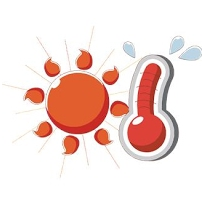 Exessive Heat Preparedness
Exessive Heat Preparedness
June 21st, 2014 marks the first day of Summer. When warmer weather approaches, it is important to know what you can do to prepare for when excessive heat is in full swing
Heat kills by pushing the human body beyond its limits. In extreme heat and high humidity, evaporation is slowed and the body must work extra hard to maintain a normal temperature.
Most heat disorders occur because the victim has been overexposed to heat or has over-exercised for his or her age and physical condition.
Older adults, young children,and those who are sick or overweight are more likely to succumb to extreme heat.
Conditions that can induce heat-related illnesses include stagnant atmospheric conditions and poor air quality.
Preparedness is the key to protecting yourself from heat related injury.
Some terms, as they relate to Heat Exposure
http://www.ready.gov/heat
Heat Wave
Prolonged period of excessive heat, often combined with excessive humidity.
Heat Index
A number in degrees Fahrenheit (F) that tells how hot it feels when relative humidity is added to the air temperature. Exposure to full sunshine can increase the heat index by 15 degrees.
Heat Cramps
Muscular pains and spasms due to heavy exertion. Although heat cramps are the least severe, they are often the first signal that the body is having trouble with the heat.
Heat Exhaustion
Typically occurs when people exercise heavily or work in a hot, humid place where body fluids are lost through heavy sweating. Blood flow to the skin increases, causing blood flow to decrease to the vital organs. This results in a form of mild shock. If not treated, the victim’s condition will worsen. Body temperature will keep rising and the victim may suffer heat stroke.
Heat Stroke
A life-threatening condition. The victim’s temperature control system, which produces sweating to cool the body, stops working. The body temperature can rise so high that brain damage and death may result if the body is not cooled quickly.
Sun Stroke
Another term for heat stroke.
Here are some tips to prepare for
the excessive heat filled summer months:
Information below provided from the CDC's Extreme Heat and Youth Health webpage.
Keep your body temperature cool to avoid heat-related illness.
- Stay in air-conditioned buildings as much as possible.
- Find an air-conditioned shelter.
- Do not rely on a fan as your primary cooling device.
- Avoid direct sunlight.
- Wear lightweight, light-colored clothing.
- Take cool showers or baths.
- Check on those most at-risk twice a day.
Because your body loses fluids through sweat, you can become dehydrated during times of extreme heat.
- Drink more water than usual.
- Don’t wait until you’re thirsty to drink more fluids.
- Drink from two to four cups of water every hour while working or exercising outside.
- Avoid alcohol or liquids containing high amounts of sugar.
- Remind others to drink enough water.
Stay updated on local weather forecasts so you can plan activities safely when it’s hot outside.
- Check local news for extreme heat alerts and safety tips.
- Learn the symptoms of heat illness.
- For more information, please click here.
Below are Warning Signs and Symptoms of Heat-Related Illness
Information below provided from the CDC's Extreme Heat and Youth Health webpage.
| Heat Exhaustion -------------------------> ·Heavy sweating ·Weakness ·Cold, pale, and clammy skin ·Fast, weak pulse ·Nausea or vomiting ·Fainting |
What You Should Do: · Move to a cooler location. · Lie down and loosen your clothing. · Apply cool, wet cloths to as much of your body as possible. · Sip water · If you have vomited and it continues, seek medical attention immediately. |
| Heat Stroke---------------------------------> · High body temperature (above 103°F)* · Hot, red, dry or moist skin · Rapid and strong pulse · Possible unconsciousness |
What You Should Do: · Call 911 immediately — this is a medical emergency. · Move the person to a cooler environment. · Reduce the person's body temperature with cool cloths or even a bath. · Do NOT give fluids. |
For more information on Extreme Heat and what you can do to protect you and your family, please visit these websites:
Virginia Department of Health
Centers for Disease Control and Prevention (CDC)
Virginia Department of Environmental Quality - Air Quality Report
Back to top
Hurricane Preparedness
ARE YOU PREPARED FOR HURRICANE SEASON???
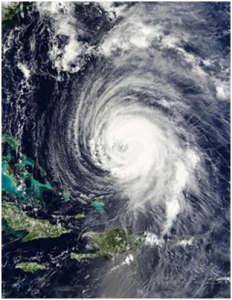
Hurricane Season in the Mid-Atlantic region stretches from
June 1 to November 30, with the peak of the season for Virginia
being August through October.

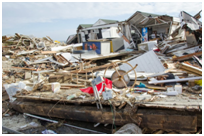

Before the storm, take precautions at home!
- Make an emergency communications plan
- Build an emergency preparedness kit
- Know what flood zone you live in
- Know your hurricane evacuation routes
- Make sure trees and shrubs are trimmed
- Clear loose and clogged rain gutters.
- Reinforce your garage doors; if wind enters a garage it can cause dangerous and expensive structural damage.
- Tie down or bring outdoor furniture, decorations, garbage cans inside.
Is it a watch or a warning?
A hurricane watch means there is a threat of hurricane conditions within the next 24-36 hours.
A hurricane warning means hurricane conditions are expected in less than 24 hours.
It is important to know the difference between a watch and a warning so that you will have enough time to prepare.
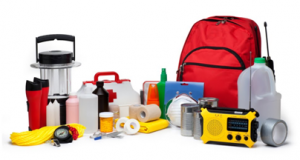
Continue to listen for the most local, up-to-date information from emergency officials. including:
- Orders to evacuate
- Details about evacuation routes
- Locations of evacuation shelters
- How to safely stay where you are
- Where to find assistance
- Weather warnings and watches
For additional hurricane preparedness resources,
click on any of the following links below:
- Ready.gov
- FEMA National Flood Insurance Program
- City of Virginia Beach Emergency Preparedness Information
- National Weather Service / National Hurricane Center
- Virginia Department of Emergency Management/Ready.gov
- Virginia Department of Transportation Hurricane Evacuation Guide
Back to top
National Preparedness Month
SEPTEMBER IS NATIONAL PREPAREDNESS MONTH!!!
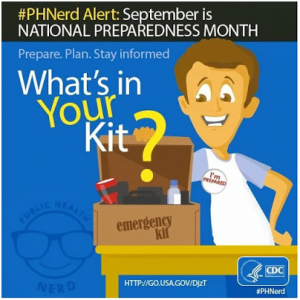
During National Preparedness Month, let your #PHNerd shine by sharing what’s in your kit
& showing loved ones that protection during emergencies begins with preparedness. http://go.usa.gov/DjzT
Planning For Special Needs
Emergencies can happen any time and any place.
Even if they don't directly affect you, they can have an impact on your daily life and well-being.
Emergencies can be especially challenging for people who:
- Cannot move around quickly or easily
- Rely on medications, medical equipment or assistance from others
- Have other special needs.
Preparing for emergencies can give you and your loved ones peace of mind.
The more prepared you are for an emergency, the safer and more comfortable you'll be until help arrives.
Evacuation for Special Needs
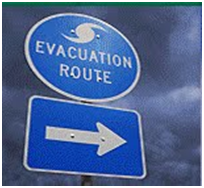
There may be times when you need to decide whether or not to evacuate. At other times, you may not have a choice. Either way, it is important to stay calm and think clearly.
Plan to stay with loved ones, if possible.
Make sure you know who you can stay with ahead of time. Consider which loved ones can assist you with your medical needs. If you have pets, ask if they can come with you.
Research hotels or motels in advance.
Call hotels or motels outside your local area. Find out if they can meet your specific needs. For example, are they handicapped accessible? Or, do they allow pets in an emergency situation? Alert staff of any emergency medical care you might require as soon as you check in.
Make transportation arrangements in advance, if needed.
Ask loved ones and network members if they can transport you during an evacuation. If you require a handicapped-accessible vehicle, ask your local emergency management office about transportation services. Make sure you have a backup plan in place, too.
Consider emergency shelters, too.
If staying with loved ones is not possible, you may need to go to an emergency management office to find out where you can go. Find out if each shelter meets your needs. For example, you might ask:
- "Does it have a wheelchair ramp?"
- "Does it have TTY phone capabilities?"
- "Does it have a handicapped-accessible bathroom?"
- "What type of medical supplies will be available?"
Stay alert to evacuation orders from local officials.
If possible, evacuation orders will be broadcast on radio or TV. Follow the travel routes outlined by authorities.
If local authorities order you to evacuate, do so immediately.
Follow these important steps.
- If possible, tell your out-of-town contact person where you are going.
- If instructed to, have the water, electricity and gas turned off at the main switches in your home. (Learn how to do this ahead of time.)
- Take your grab-and-go emergency kit and any other needed supplies. (Shelters may be able to provide some supplies but not all.)
- Lock your home.
If you are unable to evacuate by yourself, be sure network members know and practice an evacuation plan with you.
Also ask about evacuation plans where you work, go to school or volunteer. Remember to share those plans with your support network.
For more information about preparing for an emergency for someone with special need Please watch the following video:
Medical Reserve Corp
Va. Beach Medical Reserve Corps (MRC)
Are you interested in becoming a volunteer to help during a Public Health Emergency?
If you answered yes, then apply to be part of the Virginia Beach Medical Reserve Corps Team!
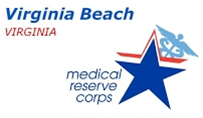
Visit our website www.vbmrc.org for more information and to sign up.
Don't forget to visit us on facebook!
Virginia Beach Medical Reserve Corp FAQ's
What is the purpose of the VBMRC unit?
The purpose of the MRC program is to strengthen the community by establishing a local team of trained medical, public health, and other community volunteers. After September 11, thousands of Americans responded by volunteering to help in any way they could. Many more asked, "What can I do to help?" The MRC brings volunteers together to supplement existing local emergency plans and resources in cities, towns, and counties throughout the United States.
Who can volunteer for the Virginia Beach Medical Reserve Corps?
A wide range of health professionals is needed to create an effective MRC unit:
Practicing, retired, or otherwise employed medical professionals, such as physicians, dentists, nurses, emergency medical technicians, pharmacists, physician assistants, advanced practice nurses, medical assistants, nursing assistants, and others. Public Health professionals.Community members without medical training are also needed to volunteer to assist with administrative and other essential support functions.
What do VBMRC volunteers do?
Volunteer roles will vary depending on the nature of the emergency and the ongoing need for community health outreach and education.
Since major emergencies can overwhelm the capabilities of our first responders, especially during the first 12 to 72 hours, MRC volunteers will be trained and used to work in coordination with existing local emergency response programs.
Medical and other health volunteers can provide an important "surge" capacity during that critical period. They may also be used to augment medical staff shortages at local medical and emergency facilities. Additionally,
VBMRC volunteers will be called to help staff dispensing sites in the event of the need for mass vaccination or mass prophylaxis. They are also utilized as medical staff during hurricane or other shelter operations.
MRC volunteers can also assist with local public health initiatives such as TB screenings, flu vaccinations, blood drives, and other outreach programs.
Visit our website www.vbmrc.org for more information and to sign up.
Other Resources
To access the different web pages below, click on the icons.

The City of Virginia Beach Emergency Preparedness and Response is a Team effort between the public and City government. The following emergency preparedness information is provided by the City of Virginia Beach to assist you in protecting your family and property in the case of an emergency situation.

The Virginia Department of Health's mission is to achieve and maintain optimum personal and community health by emphasizing health promotion, disease prevention and environmental protection.
![]()
The Virginia Department of Emergency Management – Protecting the lives and property of Virginia's citizens from emergencies and disasters by coordinating the state's emergency preparedness, mitigation, response and recovery efforts.
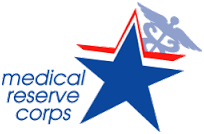
Reserve Corps is dedicated to establishing teams of local volunteer medical and public health professionals to contribute their skills and expertise throughout the year as we as during times of community need.
Want to become part of the Virginia Beach MRC? Visit www.vbmrc.org

U.S. Department of Homeland Security promotes individual emergency preparedness through the Ready Campaign and Citizen Corps as part of a broader national effort conducted by the Department's Preparedness Directorate.
